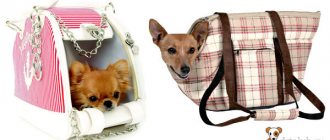When going on a trip on public transport with a pet, you need to know what the conditions for its transportation are and what features of the physiology and psychology of the pet must be taken into account so that the trip is comfortable and without problems.
Before transporting a cat on a train, find out what requirements the carrier (for example, Russian Railways) imposes on live luggage and what documents you need to stock up on.
Regulatory regulation
The conditions for transporting animals on a train in Russia are regulated by the following documents:
- “Charter of Railway Transport” with additions and amendments of 2021
- Order of the Ministry of Transport of the Russian Federation “On approval of the Rules for the transportation of passengers, luggage, cargo luggage by rail” No. 473, as amended in 2021 (clause XIV and clause XVI).
- By Order of the Ministry of Agriculture of the Russian Federation dated December 27, 2016 No. 589.
When exporting animals outside the state, it is necessary to take into account the laws of the country to which the pet is traveling. Preparations for the trip must begin in advance in order to have time to fill out documents, prepare the cat for the trip and notify the carrier. The transport company reserves the right to choose a seat on the train for transporting a cat.
The nuances of transporting animals of different sizes
A dog on a train is a potential danger to passengers. Even if your animal does not show aggression, others will treat it with distrust. Therefore, it is necessary to make sure that everyone is comfortable and does not create conflict situations.
Small dogs and puppies must be carried in a carrier or small crate. To prevent the animal from becoming nervous and barking for no reason, accustom it to its temporary home in advance. The dog must understand that nothing bad will happen to it while being carried. The container must be in your seat or carry-on luggage rack. There should not be more than 2 animals in one carrier.
Large dogs are transported only in specially designated carriages. The animal must be on a leash and muzzle. It should not pose a danger to other passengers and conductors.
The passenger himself is responsible for the cleanliness of the carriage, so it is recommended to take care of walking your pet in advance so that it goes to the toilet outside and not on the train. Large breed dogs cannot be transported in a reserved seat carriage.
Rules for transporting cats on trains
You can transport a cat on a train in a container: a bag, a basket, a house, the size of which is 55x35x25 cm. The bottom is covered with insulating and absorbent material, the walls ensure free air circulation. The container has a lock that prevents the animal from leaving without permission or access to it by unauthorized persons.
The volume of the container allows the cat to stand up, stretch, and take a few steps. Without providing comfort to the cat, it does not allow the vehicle to become dirty.
The carrying bag must be in the field of view of the accompanying person: on the lap, in a place specially designated for hand luggage. It is not recommended to place your pet under your feet or seats, so that the vibration of the vehicle floor, the hum and knock of wheels, and the flickering of passengers' legs do not traumatize the animal's psyche.
In the aisles, the container will interfere with the movement of fellow travelers. It is allowed to transport 1 animal per 1 issued ticket (but no more than 2 per carriage).
Cats cannot be transported if they:
- are sick or look sick;
- not accustomed to a container;
- dirty and emit an unpleasant odor;
- not domesticated;
- pose a threat to the health and life of passengers.
Before purchasing a ticket, you need to find out at the ticket office or the Russian Railways website whether cats can be transported in this type of carriage. For the convenience of users, an icon in the shape of an animal’s paw is placed opposite the type of carriage. If it is crossed out, then it is prohibited to transport a cat in such a carriage. Animals cannot be transported in double compartments (SV) and luxury carriages.
Long distance transport
Transporting a cat on long-distance trains requires special training. Not every animal can survive several days in an unusual environment. You should take care to purchase a special container that will ensure maximum comfort and safety for your pet.
Modern devices for transporting small pets are equipped with a drinking bowl, food container, and toilet. A special fabric cover allows you to isolate your pet from passengers and reduce stress. If the cat is traveling for the first time, then it is necessary to accustom it to transportation in advance.
The responsibilities of the attendant include maintaining the sanitary and hygienic condition of the vehicle and providing the animal with the usual food and water. The cat must not be released from the container and allowed to move around the carriage. It is not recommended to feed or touch the pet to other passengers. You can walk your cat while the train is parked for a long time on a leash to prevent it from escaping.
Before traveling, your pet should not be fed for 4 hours to avoid problems with motion sickness. The owner must think in advance about the process of feeding the animal and the possibility of cleaning the toilet, so as not to cause disturbance to others.
If the cat is restless or sensitive, then it is necessary to consult a veterinarian about medication support - safe sedatives and sedatives.
Suburban service
On electric and commuter trains, you can transport an animal without a special container; a bag or basket is enough. You can hold your pet in your arms if it already has experience with such trips and does not try to escape.
A train employee may require the cat to be placed in a container if the seats are not separated by handrails.
In accordance with the Rules of January 10, 2017, a passport and veterinary certificate are not required to transport a cat on commuter trains, but a fee is charged for their transportation, which does not exceed 25% of the cost of a ticket for an adult passenger traveling on this route.
High speed trains
The conditions for transporting pets on high-speed trains are as follows:
- Transportation is carried out on a paid basis.
- A travel document is issued at the railway ticket office or when ordering an electronic ticket.
- On the Sapsan train, the cat is transported in an economy class carriage and a meeting compartment, which is purchased in its entirety. You cannot carry a pet in business class. His carrier is placed opposite the service seats in car No. 3 (13) under the supervision of a conductor.
- Carriage in Lastochkas of the Federal Passenger Company (FPK) is permitted in class 2B carriages. In Lastochka Premium, cats cannot be transported in business class carriages. In the “Swallows” of the Directorate of High Speed Transport (DOSS), transportation is limited to carriage No. 5 (10).
- In Strizhi it is similar for FPK cars.
Before purchasing a ticket, you should familiarize yourself with the rules for transporting animals on this train and inform the carrier of your intention to transport your pet at least 2 days before the trip.
In which carriage is it possible to transport
According to Russian Railways rules, cats are transported in boxes, baskets, cages, containers, which must be placed in places intended for hand luggage.
Cats must be transported in special carriers
The transportation of cats on trains formed by JSC FPC is not permitted in all types of cars. Before purchasing a ticket, make sure that the type of carriage for which you are purchasing a ticket allows such transportation.
| type | car class | conditions of transportation |
| soft | 1A, 1I, 1M | for free |
| lux (SV) | 1E "Strizh", 1B | for free |
| 1E, 1U, 1L, 1F | free when you buy the entire compartment | |
| 1D, 1X, 1T | cannot be transported | |
| coupe | 2E, 2B, 2F, 2C | free when you buy the entire compartment |
| 2K, 2U, 2L, 2N | paid without repurchase of the entire compartment | |
| 2D, 2T, 2X | cannot be transported | |
| reserved seat | 3D, 3U, 3B | paid without purchasing additional seats |
| 3E, 3T, 3L, 3P | cannot be transported | |
| with seating | 1B, 1J | for free |
| 2B, 2ZH, 3ZH | paid without purchasing additional seats | |
| 1P, 2P 3P (based on coupe) 1C, 2C, 2E, 2M, 3C | cannot be transported | |
| general carriage | 3O | paid without purchasing additional seats |
| 3B | cannot be transported |
Animal documentation
From January 10, 2017, a veterinary certificate is no longer required to transport animals on trains within the country. No documents are needed if the transportation does not serve commercial purposes (resale or transfer of ownership of the pet). All you need is a travel document.
When transporting a pet outside the Russian Federation or for commercial purposes, you must:
- Carry with you the cat’s veterinary passport with notes on vaccinations and mandatory antiparasitic measures (deworming, treating the animal for fleas and ticks). When exporting abroad, a mark indicating that the animal is microchipped is required. Information must be duplicated in English.
- Have with you an International Veterinary Certificate, and when exporting a pet to EU countries - a document in the appropriate form approved by EU Commission Decision No. 2011/874 (EU) of 12/15/2011. It has a limited validity period and is issued by the territorial departments of Rosselkhoznadzor.
- When entering some countries, you must fill out an import declaration at the station.
- Get vaccinated against rabies and be tested in a special laboratory for the presence of antibodies to rabies.
You should find out how to transport a cat across state borders in advance - 1-2 months in advance. The rules for importing/exporting animals can be found on the website of the customs service of a given state.
How to take animals abroad
If you plan to travel with an animal outside of Russia, then pay attention to the rules for importing cats into the following countries.
Ukraine and Belarus : animals can only be transported in a compartment; it must be purchased in its entirety. Cats must travel in cages, baskets, containers, boxes in all carriages, except for SV and catering carriages, payment is the same as for 20 kg of luggage.
Europe : if you are traveling not only by Russian trains, read the rules of the carriers whose services you are going to use. There may be nuances. Special conditions may apply on night trains. Cats are carried in suitable means as hand luggage, free of charge.
UK and Norway : import/export of pets is prohibited.
China, Mongolia, North Korea, Vietnam : you can only bring pets with you. It is allowed to travel only in 2nd class carriages (compartments), no more than two animals per compartment, all seats are purchased.
Finland. You can take with you no more than two cages with cats (the size of each cage is no more than 60x45x40 cm). The veterinary certificate for each animal must be in Russian + one of the following: Finnish, Swedish or English. It must be in the officially accepted form in the EU countries. Vaccination notes made in animal passports of European Community countries are also suitable and sufficient for transportation. Russian animal passports are not suitable. Animals can only be transported in a compartment carriage; all seats in the compartment must be bathed.
Before taking your pet on trips abroad, study the rules for importing animals into your country of destination.
Sedatives for cats during transport
Transportation in a container causes stress and inappropriate behavior in your furry pet. Depending on the type of transportation, mild or strong sedatives may be used. Some will simply help the cat calm down, others will put it to sleep for the required period of time.
Preparations made on a natural basis are gentle. They contain a set of herbs that help calm the animal. They can be purchased freely at the pharmacy.
Important! When using the medicine, you should contact your veterinarian to correctly calculate the dosage. These drugs are mainly sold by prescription.
If the pet is calm in character, then herbal remedies will be enough for him. Some animals do not react at all to a radical change in environment, so herbal preparations can be given as a safety net.
Travel abroad
Each country has its own rules. It is better to find out the rules for transporting animals in advance to avoid conflict situations.
In most countries, the same rules apply as in Russia - small dogs are transported in a carrier or container, and large dogs are transported on a leash and muzzle. In some European countries it is forbidden to import animals at all; in others, the dog will have to be quarantined after arrival.
Before traveling, you should check the following rules in your specific country:
- is it allowed to import a specific breed of dog into the state;
- what documents are required;
- what vaccinations should be given and when;
- Does the animal need a chip?
When traveling abroad, the owner usually buys all the seats in the compartment and freely transports a dog of any size. Trains traveling to Asian countries have separate compartments for animals.











